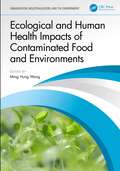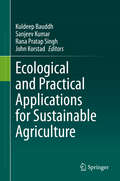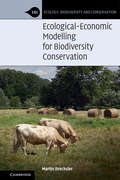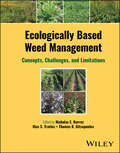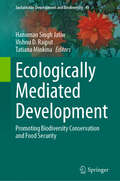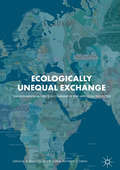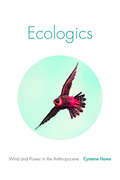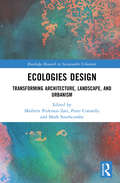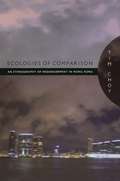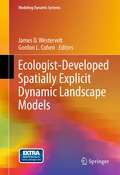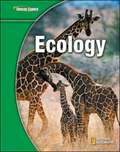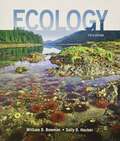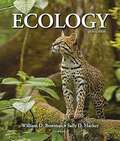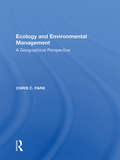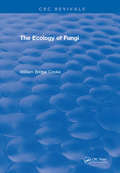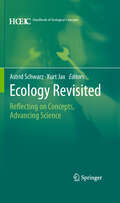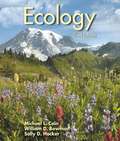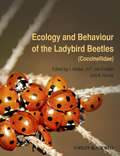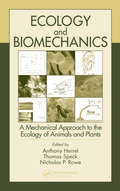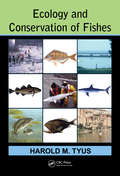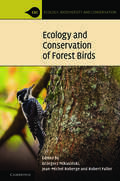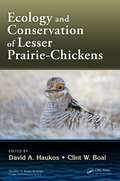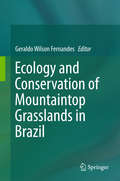- Table View
- List View
Ecological and Human Health Impacts of Contaminated Food and Environments (Urbanization, Industrialization, and the Environment)
by Ming Hung WongThis book discusses linkages between the natural and disturbed chemical composition of the earth's surface and ecological and human health. It reviews the environmental geochemical cycles of natural elements and persistent toxic substances (PTS) in the environment, highlighting the degradation of soil and water resources due to human activities such as extraction and usage of minerals. There is an attempt to provide evidence concerning the health effects of consuming contaminated food, due to frequent consumption of mercury-laden fish. Lastly, sources, fates, and ecological effects of various PTS are presented, including microplastics and associated chemicals. Details linkages between the natural and disturbed chemical composition of the earth’s surface, and environmental and human health, focusing on food contamination Discusses emerging pollutants with potential widespread hazardous effects such as bisphenol A and phthalates Reviews safe food production and quality, as well as the management, regulation and policies concerning toxic chemicals Contains cutting edge knowledge on safe food production and remediating technologies Describes how geochemical cycling results in food contamination
Ecological and Practical Applications for Sustainable Agriculture
by Rana Pratap Singh Kuldeep Bauddh Sanjeev Kumar John KorstadRampant industrialization, urbanization, and population growth have resulted in increased global environmental contamination. The productivity of agricultural soil is drastically deteriorated and requires a high dose of fertilizers to cultivate crops. To ensure food security, farmers are compelled to apply excess chemical fertilizers and insecticides that contaminate soil, air, and water. Heavy loads of chemical fertilizers not only degrade the quality of agricultural land but also pollute water and air. Use of chemical fertilizers also accelerate the release of greenhouse gases like nitrous oxide and methane along with nutrient runoff from the watershed in to lower elevation rivers and lakes, resulting in cultural eutrophication.Farming practices globally in developed, developing, and under-developing countries should utilize and promote sustainable methods through viable combined environmental, social, and economic means that improve rather than harm future generations. This can include use of non-synthetic fertilizers like compost, vermicompost, slow-release fertilizers, farmyard manures, crop rotations that include nitrogen-fixing legumes. Organic fertilizers like compost and vermicompost improve soil properties like texture, porosity, water-holding capacity, organic matter, as well as nutrient availability. The purpose of this book is to document the available alternatives of synthetic fertilizers, their mode of action, efficiency, preparation methodology, practical suggestions for sustainable practices, and needed research focus. The book will cover major disciplines like plant science, environmental science, agricultural science, agricultural biotechnology and microbiology, horticulture, soil science, atmospheric science, agro-forestry, agronomy, and ecology. This book is helpful for farmers, scientists, industrialists, research scholars, masters and graduate students, non-governmental organizations, financial advisers, and policy makers.
Ecological-Economic Modelling for Biodiversity Conservation (Ecology, Biodiversity and Conservation)
by Martin DrechslerEcologists and economists both use models to help develop strategies for biodiversity management. The practical use of disciplinary models, however, can be limited because ecological models tend not to address the socioeconomic dimension of biodiversity management, whereas economic models tend to neglect the ecological dimension. Given these shortcomings of disciplinary models, there is a necessity to combine ecological and economic knowledge into ecological-economic models. Gradually guiding the reader into the field of ecological-economic modelling by introducing mathematical models and their role in general, this book provides an overview on ecological and economic modelling approaches relevant for research in the field of biodiversity conservation. It discusses the advantages of and challenges associated with ecological-economic modelling, together with an overview of useful ways of integration. Although being a book about mathematical modelling, ecological and economic concepts play an equally important role, making it accessible for readers from very different disciplinary backgrounds.
Ecologically Based Weed Management: Concepts, Challenges, and Limitations
by Nicholas E. Korres Ilias S. Travlos Thomas K. GitsopoulosEcologically Based Weed Management Protect crop yields and strengthen ecosystems with this essential guide Research into weed management is an increasingly critical component of both environmental stewardship and food production. The potential cost of weed propagation can be measured in crop yield reductions, under-nourished populations, stymied economies, and more. The propagation of herbicide-resistant weed populations means that purely chemical weed management is no longer viable; food production can now be secured only with an ecological approach to weed control. Ecologically Based Weed Management details such approaches and their potential to manage weeds across a range of agricultural and environmental contexts. It emphasizes the deployment of ecological principles to prevent weed infestations, reduce crop losses, and strengthen ecosystems. In a time when growing population and changing climates are placing enormous pressure on global food production, this approach to weed management has never been more vital. Ecologically Based Weed Management readers will also find: A global team of expert contributors to a multidisciplinary approach Detailed discussion of topics like herbicide limitation, integrated weed management, and more Insights pertinent to agriculture, academia, government, industry, and more Ecologically Based Weed Management is ideal for researchers in agriculture chemistry, weed science, agronomy, ecology, and related fields, as well as for regulators and advanced students.
Ecologically Mediated Development: Promoting Biodiversity Conservation and Food Security (Sustainable Development and Biodiversity #41)
by Hanuman Singh Jatav Tatiana Minkina Vishnu D. RaiputThis edited volume addresses the critical need to balance biodiversity preservation with ensuring a nutritious and ample food supply for the growing global population. It emphasizes how conserving biodiversity enhances agricultural resilience, promotes sustainable food production, and safeguards food security for present and future generations. The book explores the complex interdependence between biodiversity and food security, identifying both challenges and threats, presenting solutions and strategies, and examining the roles of policies, governance, regulations, and international agreements. It highlights the importance of fostering research and raising awareness to promote sustainable agricultural practices, biodiversity conservation, and equitable resource access essential for long-term food security. The book includes real-world case studies and examples from different regions to demonstrate successful initiatives and the impact of biodiversity conservation on local food systems. This book provides a platform for researchers, conservationists, and policymakers to exchange knowledge and ideas on integrating biodiversity conservation into food security initiatives. It is a compilation of information by the experts and will be useful for researchers in the fields of botany, agriculture, nutrition, policy making and biotechnology.
Ecologically Unequal Exchange: Environmental Injustice in Comparative and Historical Perspective
by Harry F. Dahms R. Scott Frey Paul K. GellertAt a time of societal urgency surrounding ecological crises from depleted fisheries to mineral extraction and potential pathways towards environmental and ecological justice, this book re-examines ecologically unequal exchange (EUE) from a historical and comparative perspective. The theory of ecologically unequal exchange posits that core or northern consumption and capital accumulation is based on peripheral or southern environmental degradation and extraction. In other words, structures of social and environmental inequality between the Global North and Global South are founded in the extraction of materials from, as well as displacement of waste to, the South. This volume represents a set of tightly interlinked papers with the aim to assess ecologically unequal exchange and to move it forward. Chapters are organised into three main sections: theoretical foundations and critical reflections on ecologically unequal exchange; empirical research on mining, deforestation, fisheries, and the like; and strategies for responding to the adverse consequences associated with unequal ecological exchange. Scholars as well as advanced undergraduate and graduate students will benefit from the spirited re-evaluation and extension of ecologically unequal exchange theory, research, and praxis.
Ecologics: Wind and Power in the Anthropocene
by Cymene HoweBetween 2009 and 2013 Cymene Howe and Dominic Boyer conducted fieldwork in Mexico's Isthmus of Tehuantepec to examine the political, social, and ecological dimensions of moving from fossil fuels to wind power. Their work manifested itself as a new ethnographic form: the duograph—a combination of two single-authored books that draw on shared fieldsites, archives, and encounters that can be productively read together, yet can also stand alone in their analytic ambitions. In her volume, Ecologics, Howe narrates how an antidote to the Anthropocene became both failure and success. Tracking the development of what would have been Latin America's largest wind park, Howe documents indigenous people's resistance to the project and the political and corporate climate that derailed its renewable energy potential. Using feminist and more-than-human theories, Howe demonstrates how the dynamics of energy and environment cannot be captured without understanding how human aspirations for energy articulate with nonhuman beings, technomaterial objects, and the geophysical forces that are at the heart of wind and power.
Ecologies Design: Transforming Architecture, Landscape, and Urbanism (Routledge Research in Sustainable Urbanism)
by Peter Connolly Maibritt Pedersen Zari Mark SouthcombeThe notion of ecology has become central to contemporary design discourse. This reflects contemporary concerns for our planet and a new understanding of the primary entanglement of the human species with the rest of the world.The use of the term ‘ecology’ with design tends to refer to how to integrate ecologies into design and cities and be understood in a biologically-scientific and technical sense. In practice, this scientific-technical knowledge tends to be only loosely employed. The notion of ecology is also often used metaphorically in relation to the social use of space and cities. This book argues that what it calls the ‘biological’ and ‘social’ senses of ecology are both important and require distinctly different types of knowledge and practice. It proposes that science needs to be taken much more seriously in ‘biological ecologies’, and that ‘social ecologies’ can now be understood non-metaphorically as assemblages. Furthermore, this book argues that design practice itself can be understood much more rigorously, productively and relevantly if understood ecologically. The plural term ‘ecologies design’ refers to these three types of ecological design. This book is unique in bringing these three perspectives on ecological design together in one place. It is significant in proposing that a strong sense of ecologies design practice will only follow from the interconnection of these three types of practice. Ecologies Design brings together leading international experts and relevant case studies in the form of edited research essays, case studies and project work. It provides an overarching critique of current ecologically-oriented approaches and offers evidence and exploration of emerging and effective methods, techniques and concepts. It will be of great interest to academics, professionals and students in the built environment disciplines.
Ecologies of Comparison: An Ethnography of Endangerment in Hong Kong
by Timothy ChoyA rich ethnography of ecopolitics in Hong Kong in the late 1990s, as the region shifted to Chinese sovereignty, Ecologies of Comparison describes how ecological concepts of uniqueness and scale resonated among environmentalists, including those seeking to preserve a species of white dolphin, to protect an aging fishing village from redevelopment, and to legitimize air quality as an object of political and medical concern. During his research, Tim Choy became increasingly interested in the power of the notion of specificity. While documenting the expert and lay production of Hong Kong's biological, cultural, and political specificities, he began comparing the logics and narrative forms that made different types of specificity--such as species, culture, locality, and state autonomy--possible and meaningful. He came to understand these logics and forms as "ecologies of comparison," conceptual practices through which an event or form of life comes to matter in environmentalist and other political terms. Choy's ethnography is about environmentalism, Hong Kong, and the ways that we think about environmentalism in Hong Kong and other places. It is also about how politics, freedom, culture, expertise, and other concepts figure in comparison-based knowledge practices.
Ecologist-Developed Spatially-Explicit Dynamic Landscape Models
by James D. Westervelt Gordon L. CohenThis book is written for ecologists interested in capturing their understandings of how natural systems work in software - to help inform their work and communicate the consequences of proposed management plans. Historically, ecologists had to rely on the skills of trained computer programmers to modeling natural systems, but now a new generation of software is allowing ecologists to directly capture their understandings of systems in software. This book is a compilation of spatially explicit simulation models developed by ecologists and planners without any formal computer programming skills. Readers will be inspired to believe that they too can create similar models of the systems with which they are familiar.
Ecology
by Glencoe McGraw-Hill StaffGlencoe Science: Ecology, a module in the Glencoe Science 15 book series, provides students with accurate and comprehensive coverage of middle school National Science Education Standards. Concepts are explained in a clear, concise manner, and are integrat
Ecology
by William D. Bowman Sally D. HackerThe bestselling textbook for undergraduate ecology courses, Ecology is an easy-to-read and well-organized text for instructors and students to explore the basics of the field. Bowman and Hacker motivate students with an engaging case study-driven, conceptual approach that highlights relevant applications and data-driven examples. The new fifth edition is available in a dynamic and interactive Enhanced eBook at an affordable price.
Ecology
by William Bowman Sally HackerEcology is an easy-to-read and well-organized text for instructors and students to explore the basics and promote ecological literacy. Ecology, Sixth Edition, introduces readers to the beauty of nature and the importance of ecology and provides content in a way that engages students without overwhelming them in the process. The authors motivate students with an engaging case-study conceptual approach that highlights relevant applications and data-driven examples.
Ecology & Environ Mgmt/h
by Roger ParkThe aim of the present volume is to review the effects of human activity on physical environment processes, and this is justified not only as a complement to the approach taken by G. P. Marsh his volume Man and Nature (1864), but also as a sequel to the work produced since 1864, with contributions since the mid-nineteenth century to the study of th
Ecology And Religion
by Mary Evelyn Tucker John GrimFrom the Psalms in the Bible to the sacred rivers in Hinduism, the natural world has been integral to the world's religions. John Grim and Mary Evelyn Tucker contend that today's growing environmental challenges make the relationship ever more vital. This primer explores the history of religious traditions and the environment, illustrating how religious teachings and practices both promoted and at times subverted sustainability. Subsequent chapters examine the emergence of religious ecology, as views of nature changed in religious traditions and the ecological sciences. Yet the authors argue that religion and ecology are not the province of institutions or disciplines alone. They describe four fundamental aspects of religious life: orienting, grounding, nurturing, and transforming. Readers then see how these phenomena are experienced in a Native American religion, Orthodox Christianity, Confucianism, and Hinduism. Ultimately, Grim and Tucker argue that the engagement of religious communities is necessary if humanity is to sustain itself and the planet. Students of environmental ethics, theology and ecology, world religions, and environmental studies will receive a solid grounding in the burgeoning field of religious ecology.
Ecology Of Fungi
by William Bridge CookeOriginally published in 1979. A review of the broad subject of the ecology of fungi. Fungi, are progressive, ever changing and evolving rapidly in their own way, so that they are capable of becoming adapted to every condition of life. We may rest assured that as green plants and animals disappear one by one from the face of the earth, some of the fungi will always be present to dispose of the last remains. Ecology has been defined by Daubenmire as the study of the reciprocal relations between organisms and their environment. Fungi are heterotrophic organisms which cannot manufacture their basic food requirements and so are dependent on food materials produced by other organisms either as saprobes or parasites.
Ecology Revisited
by Kurt Jax Astrid SchwarzAs concerns about humankind's relationship with the environment move inexorably up the agenda, this volume tells the story of the history of the concept of ecology itself and adds much to the historical and philosophical debate over this multifaceted discipline. The text provides readers with an overview of the theoretical, institutional and historical formation of ecological knowledge. The varied local conditions of early ecology are considered in detail, while epistemological problems that lie on the borders of ecology, such as disunity and complexity, are discussed. The book traces the various phases of the history of the concept of ecology itself, from its 19th century origins and antecedents, through the emergence of the environmental movement in the later 20th century, to the future, and how ecology might be located in the environmental science framework of the 21st century. The study of 'ecological' phenomena has never been confined solely to the work of researchers who consider themselves ecologists. It is rather a field of knowledge in which a plurality of practices, concepts and theories are developed. Thus, there exist numerous disciplinary subdivisions and research programmes within the field, the boundaries of which remain blurred. As a consequence, the deliberation to adequately identify the ecological field of knowledge, its epistemic and institutional setting, is still going on. This will be of central importance not only in locating ecology in the frame of 21st century environmental sciences but also for a better understanding of how nature and culture are intertwined in debates about pressing problems, such as climate change, the protection of species diversity, or the management of renewable resources.
Ecology Third Edition
by Michael L. Cain William D. Bowman Sally D. HackerThe new Third Edition of Ecology remains focused on the primary goal of this bestselling book: to be the best teaching tool possible for students taking their first course in ecology. Toward that end, the authors updated, replaced, or cut sections of the text as appropriate, and they added a new chapter on Behavioral Ecology, an exciting and growing subfield of ecology that always draws high levels of student.
Ecology and Behaviour of the Ladybird Beetles (Coccinellidae)
by A. Honek I. Hodek H. F. van EmdenLadybirds are probably the best known predators of aphids and coccids in the world, though this greatly underestimates the diversity of their biology. Maximising their impact on their prey is an important element in modern conservation biological control of indigenous natural enemies in contrast to the classical approach of releasing alien species. Ivo Hodek is one of the most internationally respected experts on coccinellids who has researched these insects for his entire career. He has now brought together 14 scientists of international standing to author 12 chapters, making this book the definitive treatment of coccinellid biology and ecology. This volume covers the rapid scientific developments of recent years in the understanding of coccinellid phylogeny, the semiochemicals influencing their behaviour and of molecular genetics. Recent insights in relation to intraguild predation and the assessment of the predatory impact of coccinellids are also covered. Other special features of the volume are the extensive references covering the literature from both East and West and a taxonomic glossary of the up-to-date nomenclature for species of coccinellids as well as of other organisms mentioned in the text. While aimed at researchers, university teachers and agricultural entomologists, the book is readable and appropriate for others who just have a liking for these interesting and attractive insects.
Ecology and Biomechanics: A Mechanical Approach to the Ecology of Animals and Plants
by Anthony Herrel Thomas Speck Nicholas P. RowedWe live in a well-engineered universe. This engineering is present in every system and organism in existence, including in the actions and interactions of plants and animals. In fact, one could say that the function and movement of plants and animals is just as much a part of their makeup as chlorophyll and fiber or bone and blood. Consequently, if
Ecology and Conservation of Estuarine Ecosystems
by Renzo Perissinotto Derek D. Stretch Ricky H. Taylor Renzo Perissinotto Derek D. StretchSt Lucia is the world's oldest protected estuary and Africa's largest estuarine system. It is also the centerpiece of South Africa's first UNESCO World Heritage Site, the iSimangaliso Wetland Park, and has been a Ramsar Wetland of International Importance since 1986. Knowledge of its biodiversity, geological origins, hydrology, hydrodynamics and the long history of management is unique in the world. However, the impact of global change has culminated in unprecedented challenges for the conservation and management of the St Lucia system, leading to the recent initiation of a project in support of its rehabilitation and long-term sustainability. This timely volume provides a unique source of information on the functioning and management of the estuary for researchers, students and environmental managers. The insights and experiences described build on over 60 years of study and management at the site and will serve as a valuable model for similar estuaries around the world.
Ecology and Conservation of Fishes
by Harold M. TyusWritten as a stand-alone textbook for students and a useful reference for professionals in government and private agencies, academic institutions, and consultants, Ecology and Conservation of Fishes provides broad, comprehensive, and systematic coverage of all aquatic systems from the mountains to the oceans. The book begins with overview discussio
Ecology and Conservation of Forest Birds (Ecology, Biodiversity and Conservation )
by Robert J. Fuller Grzegorz Mikusiński Jean-Michel RobergeEcology and Conservation of Forest Birds is a unique review of the current understanding of the relationships between forest birds and their changing environments. Large ecological changes are being driven by forest management, climate change, introduced pests and pathogens, abiotic disturbances, and overbrowsing. Many forest bird species have suffered population declines, with the situation being particularly severe for birds dependent on attributes such as dead wood, old trees and structurally complex forests. With a focus on the non-tropical parts of the northern hemisphere, the text addresses the fundamental evolutionary and ecological aspects of forest birds using original data analyses and synthesising reviews. The characteristics of bird assemblages and their habitats in different European forest types are explored, together with the macroecological patterns of bird diversity and conservation issues. The book provides a valuable reference for ecologists, ornithologists, conservation professionals, forest industry employees, and those interested in birds and nature.
Ecology and Conservation of Lesser Prairie-Chickens (Studies in Avian Biology)
by Clint W. Boal David A. HaukosShortlisted for the 2018 TWS Wildlife Publication Awards in the edited book categoryLesser Prairie-Chickens have experienced substantial declines in terms of population and the extent of area that they occupy. While they are an elusive species, making it difficult at times to monitor them, current evidence indicates that they have been persistently
Ecology and Conservation of Mountaintop grasslands in Brazil
by Geraldo Wilson FernandesThis book is a pioneer attempt to bring forward the first synthesis on the most diverse and threatened mountain top vegetation of South America, the rupestrian grasslands. It brings to light the state of the art information on this ecosystem geology, soil formation and distribution, environmental filters that lead to biodiversity, species interactions and their fine tuned adaptations to survive the harsh mountain environment. The human dimensions of the rupestrian grassland are also addressed, including the anthropogenic threats that may irreversibly impact biodiversity and ecosystem services. The book also highlights the ongoing studies on ecological restoration and first attempt to model the impacts of climate change on its speciose biota.
